Introduction
Here are some examples of exercises for you to try. The exercises may be suggested for a condition or for rehabilitation. Start each exercise slowly. Ease off the exercises if you start to have pain.
You will be told when to start these exercises and which ones will work best for you.
How to do the exercises
Wrist flexion and extension
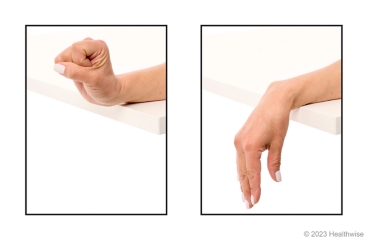
slide 1 of 10
slide 1 of 10, Wrist flexion and extension,
- Place your forearm on a table. Your affected hand and wrist should extend beyond the table, palm down.
- Bend your wrist to move your hand upward and allow your hand to close into a fist. Hold for about 6 seconds.
- Now lower your hand as far as you can and allow your fingers to straighten. Hold for about 6 seconds.
- Repeat both directions 8 to 12 times.
- It's a good idea to repeat these steps with your other hand.
Forearm pronation and supination stretch
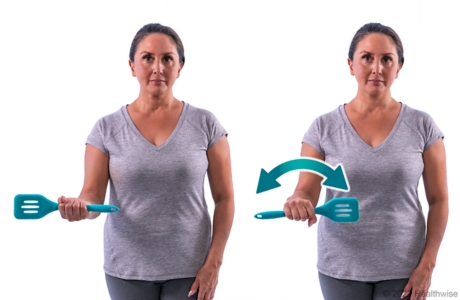
slide 2 of 10
slide 2 of 10, Forearm pronation and supination stretch,
- Keep your affected elbow at your side, bent at about 90 degrees. Grasp a thin object, like a pen, pencil, or stick, and wrap your hand around it. If you don't have something to hold on to, make a fist instead.
- Slowly turn your forearm as far as you can back and forth in each direction. Your hand should face up and then down.
- Hold each position for at least 15 to 30 seconds until you feel a stretch in your forearm.
- Repeat 2 to 4 times.
- It's a good idea to repeat these steps with your other arm.
Wrist deviation

slide 3 of 10
slide 3 of 10, Wrist deviation,
- Sit so that your affected arm is supported but your hand hangs off the edge of a flat surface, such as a table.
- Hold your hand out like you are shaking hands with someone.
- Move your hand up and down.
- Repeat this motion 8 to 12 times.
- It's a good idea to repeat these steps with your other arm.
Towel squeeze
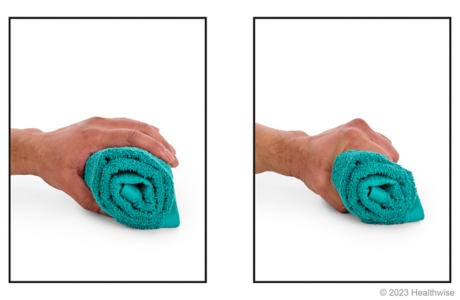
slide 4 of 10
slide 4 of 10, Towel squeeze,
- Place a small towel roll on a table.
- With your palm facing down, grab the towel. Squeeze it for about 6 seconds. Then slowly straighten your fingers to release the towel.
- Repeat 8 to 12 times.
- It's a good idea to repeat these steps with your other hand.
Resisted forearm pronation
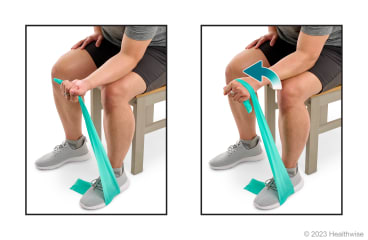
slide 5 of 10
slide 5 of 10, Resisted forearm pronation,
- Sit leaning forward with your legs slightly apart. Then place your affected forearm on your thigh with your hand and wrist in front of your knee.
- Grasp one end of an exercise band with your palm up. Step on the other end.
- Keeping your wrist straight, roll your palm inward as far as you can for a count of 2. Then slowly roll your palm back to the starting position to a count of 5.
- Repeat 8 to 12 times.
- It's a good idea to repeat these steps with your other arm.
Resisted forearm supination
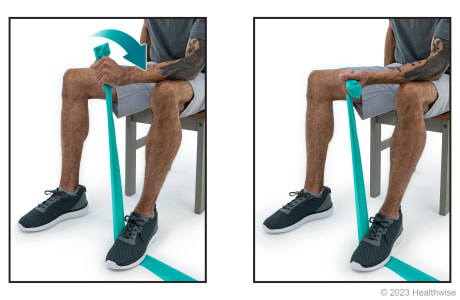
slide 6 of 10
slide 6 of 10, Resisted forearm supination,
- Sit leaning forward with your legs slightly apart. Then place the forearm of your affected arm on your thigh, with your wrist in front of your knee.
- Grasp one end of an exercise band with your palm down, and step on the other end.
- Keeping your wrist straight, roll your palm outward as far as you can for a count of 2. Then slowly roll your palm back to the starting position to a count of 5.
- Repeat 8 to 12 times.
- It's a good idea to repeat these steps with your other arm.
Resisted ulnar deviation
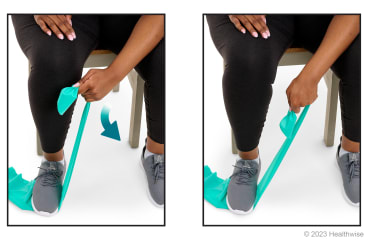
slide 7 of 10
slide 7 of 10, Resisted ulnar deviation,
- Sit leaning forward with your legs slightly apart. Then place your affected forearm on your thigh with your hand and wrist by the inside of your knee.
- Grasp one end of an exercise band with your palm down. Step on the other end with the foot opposite the hand holding the band.
- Slowly bend your wrist outward and toward your knee for a count of 2. Then slowly move your wrist back to the starting position to a count of 5.
- Repeat 8 to 12 times.
- It's a good idea to repeat these steps with your other arm.
Resisted radial deviation
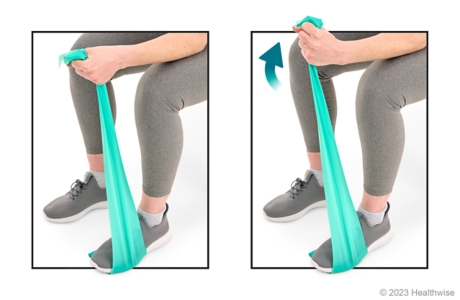
slide 8 of 10
slide 8 of 10, Resisted radial deviation,
- Sit leaning forward with your legs slightly apart. Then place your affected forearm on your thigh with your hand and wrist in front of your knee.
- Grasp one end of an exercise band with your hand facing toward your other thigh. Step on the other end of the band.
- Slowly bend your wrist upward for a count of 2. Then lower your wrist slowly to a count of 5.
- Repeat 8 to 12 times.
- It's a good idea to repeat these steps with your other arm.
Resisted wrist flexion (exercise band)
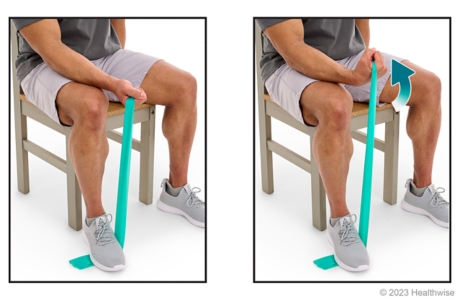
slide 9 of 10
slide 9 of 10, Resisted wrist flexion (exercise band),
- Sit leaning forward with your legs slightly apart. Then place your affected forearm on your thigh with your hand and wrist in front of your knee.
- Grasp one end of an exercise band with your palm up. Step on the other end.
- Slowly bend your wrist upward for a count of 2. Then lower your wrist slowly to a count of 5.
- Repeat 8 to 12 times.
- It's a good idea to repeat these steps with your other arm.
Resisted wrist extension (exercise band)
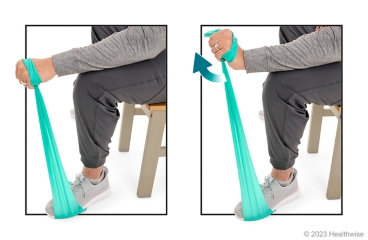
slide 10 of 10
slide 10 of 10, Resisted wrist extension (exercise band),
- Sit leaning forward with your legs slightly apart. Then place your affected forearm on your thigh with your hand and wrist in front of your knee.
- Grasp one end of an exercise band with your palm down. Step on the other end.
- Slowly bend your wrist upward for a count of 2. Then lower your wrist slowly to a count of 5.
- Repeat 8 to 12 times.
- It's a good idea to repeat these steps with your other arm.
Current as of: July 31, 2024
Author: Ignite Healthwise, LLC Staff
Clinical Review Board
All Healthwise education is reviewed by a team that includes physicians, nurses, advanced practitioners, registered dieticians, and other healthcare professionals.

